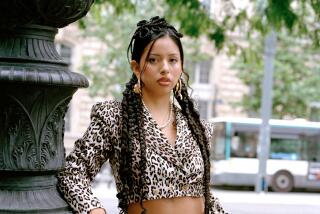Arts Preview: Choreographer-dancer Claudia Lavista explores shifting identities at UCLA
- Share via
Claudia Lavista wears many hats. She is co-artistic director of Delfos Danza Contemporánea, one of Mexico’s premier contemporary dance companies. She is also a leading choreographer, a wife and mother, a daughter, a dancer.
Probing these ever-evolving, co-existing roles formed the basis of her “Cuando los Disfraces se Cuelgan” (When the Disguises Are Hung Up), a dance performance that’s also a meditation on shifting identities and disguises — particularly the ones we wear in broad daylight daily. It will be performed at UCLA’s Royce Hall on April 14.
“You have to wear different masks for every role you play in life,” Lavista said. “It’s not that you’re hiding or cheating. It’s a survival thing. We translated that idea of masks into the body language of dance.”
FULL COVERAGE: Spring Arts Preview 2015
The piece, which Lavista created with co-artistic director Victor Manuel Ruiz, is strikingly visual and layered, incorporating music and dance, real-time video and computer animation throughout 10 or so disparate but tonally connected scenes. Layers emerge in nearly every aspect of the performance: The costumes comprise layers of translucent material. The movement progresses from fluid and delicate to grounded and athletic to violent and fast — “so the audience can journey between different body states,” Lavista said. Even the score is layered with multiple composers: Robert Schumann, Johann Sebastian Bach, Meredith Monk and Lavista’s father, Mario Lavista.
“Cuando los Disfraces se Cuelgan” is an especially intimate work, Lavista said. Within the company, dancers closely collaborated on the choreography, visuals and staging of the production; the narrative directed at the audience is introspective, meant to provoke self-reflection.
SPRING ARTS PREVIEW 2015: The lists
“We don’t want the audience to see us onstage. We want to be a mirror, so they see themselves,” Lavista said. “Everyone, everywhere lives this reality — all these roles and costumes and ways of behaving. We were struggling with that, trying to make sense of it. That’s why we wanted to make this piece — to have an intimate dialogue with the audience.”
Twitter: @debvankin
More to Read
The biggest entertainment stories
Get our big stories about Hollywood, film, television, music, arts, culture and more right in your inbox as soon as they publish.
You may occasionally receive promotional content from the Los Angeles Times.











